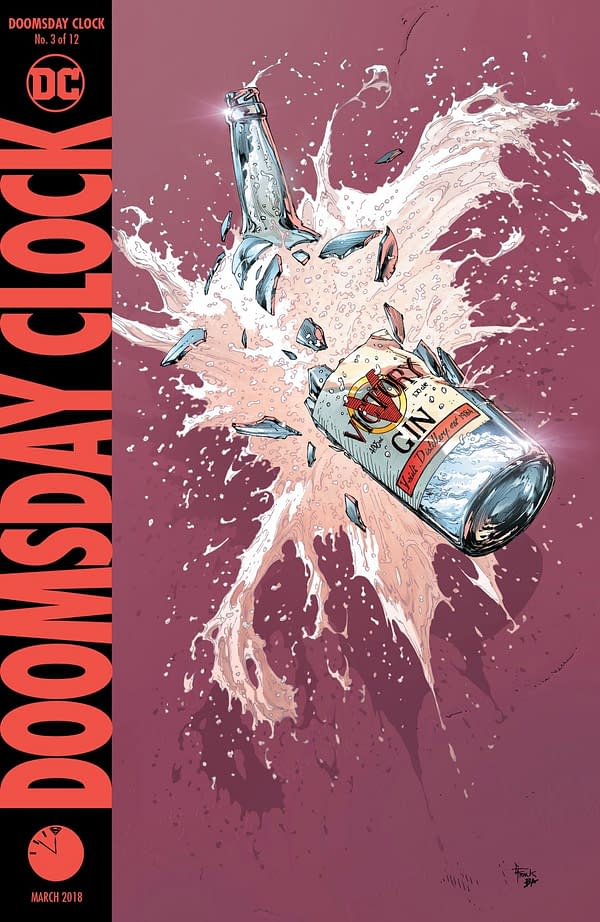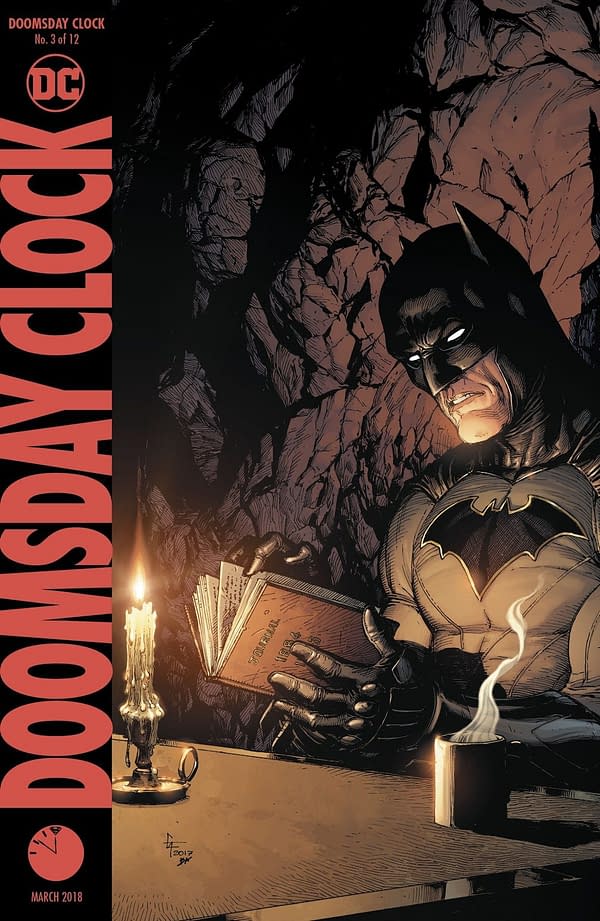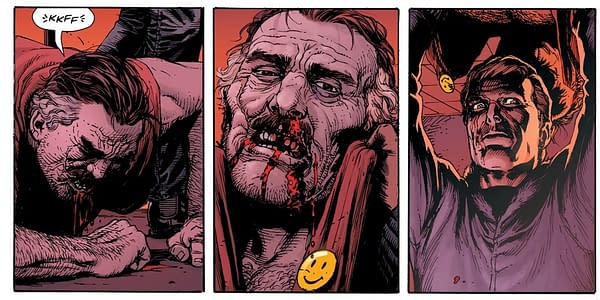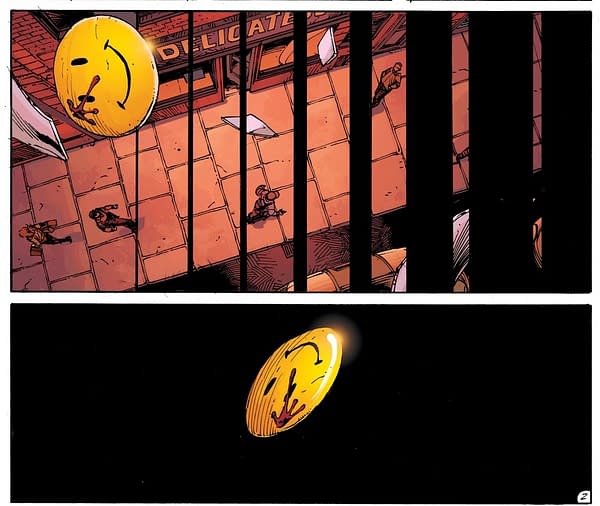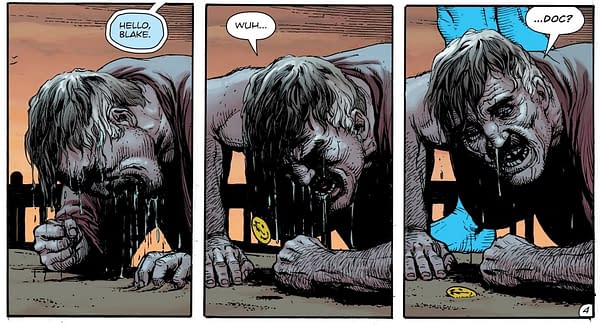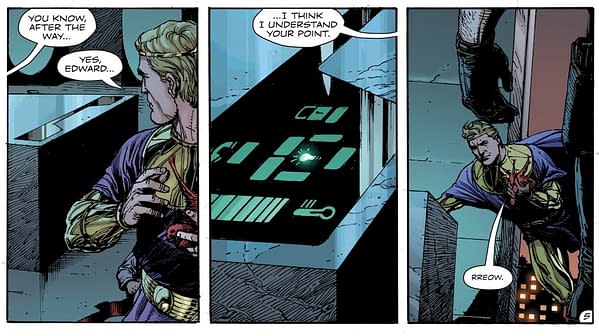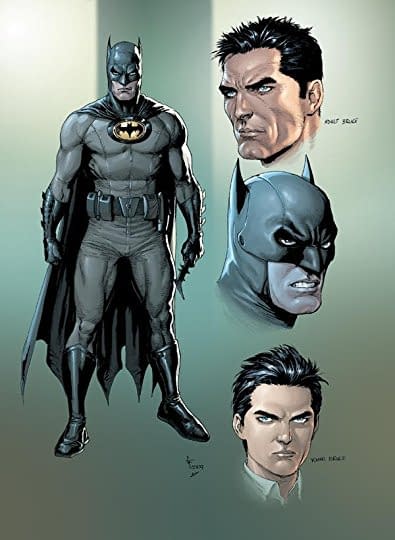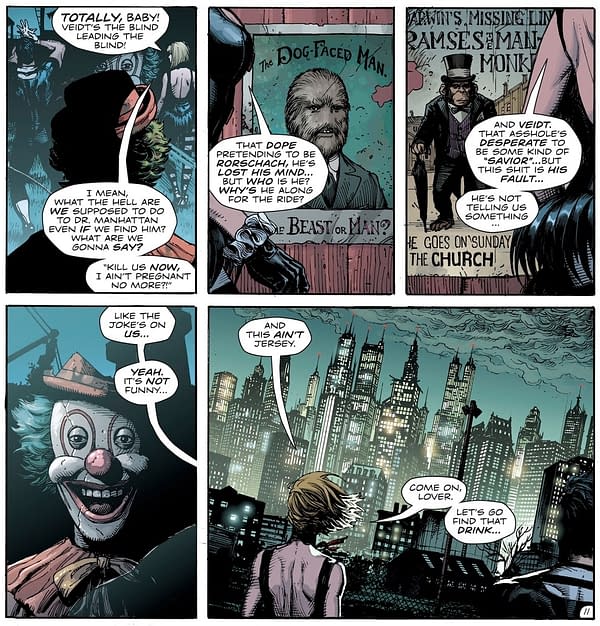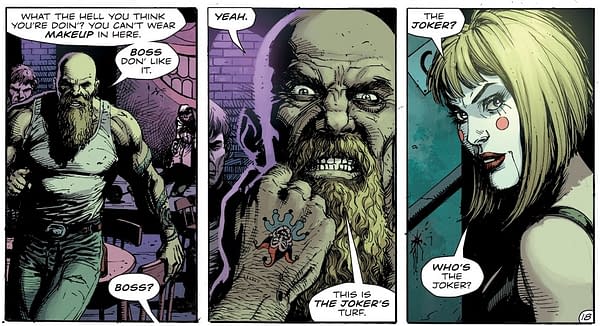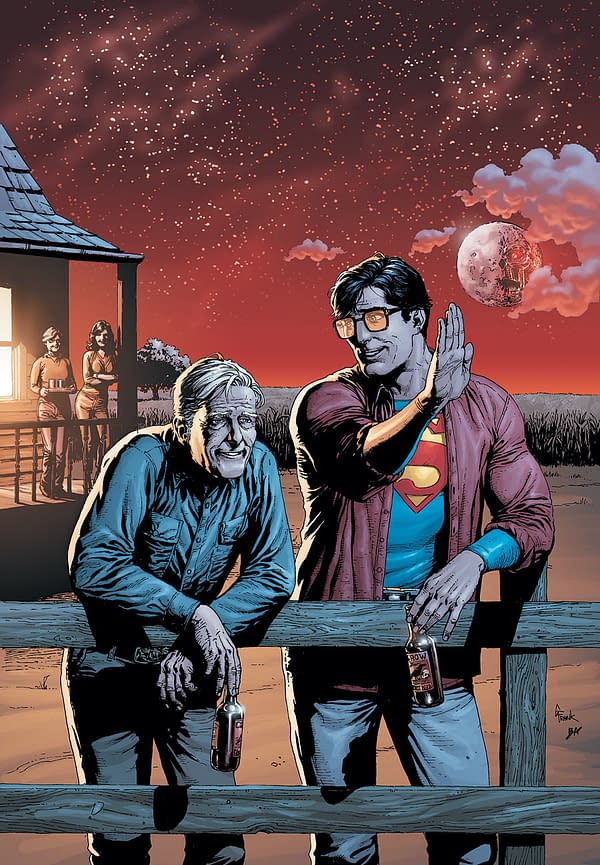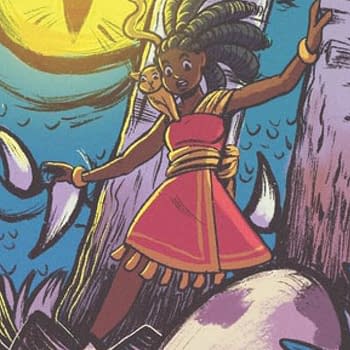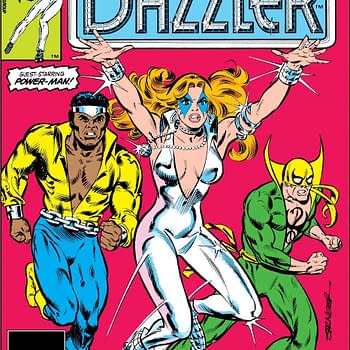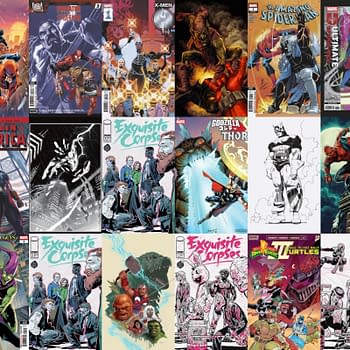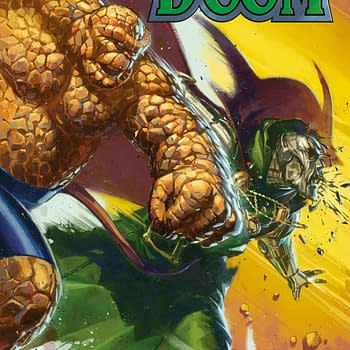Posted in: Comics | Tagged: Comics, HRL
Doomsday Clock #3, Annotated
Jason Fleece, Bleeding Cool commenter, has created an initial stab at an annotation for the unauthorised sequel to Watchmen, Doomsday Clock #3 by Geoff Johns and Gary Frank, published by DC Comics. We are pleased to be able to reproduce it below… with occasional additions from me, because I can't leave well alone.
If you see anything else of note, add them in the comments below!
Covers:
Victory Gin Veidt Distillery, est. 1984 – Victory Gin is a reference to George Orwell's 1984.
Alternate Cover
Batman reading Kovacs's journal
- Batman is wearing his Rebirth costume here, which he is not wearing in the actual issue
- Why is he reading by candlelight?
Pages 1 & 2
These pages are a flashback to Eddie Blake's murder in Watchmen.
- Panels 5 and 6 on p. 1 are very close redrawing of Gibbons's panels (composition, coloring, etc).
- Compositional similarities on p. 2 as well with the "first floor coming up" sequence from Watchmen #1
- Panel 4 on page 2 employs vertical black bars as a device to show Dr. Manhattan's teleportation from Blake's POV. Gibbons used the exact same device to show teleportation from Laurie Juspeczyk's POV when Jon teleported her to Mars in Watchmen
- Panel 5 on page 2 indicates that the smiley button didn't go with him?
[Rich adds: is this how it ended up in the Batcave?]
"Not victory nor defeat" – Hmm, victory again…
- 3
- Panel 1 – same device to depict teleportation
- Blake is still missing a tooth from Veidt's beating. Clearly Dr. Manhattan plucked Eddie from the fall leading to his death. Does this change Watchmen continuity? I doubt it. I expect that, before the series is over, Blake will be returned to 1985 on Earth-Watchmen mid-fall.
- 5
- Panel 1 – Note the Luthor tower. Blake has clearly been deposited in Metropolis. Probably Hob's Bay.
- Panel 3 – One of Dr. Manhattan's signature blue word balloons.
- Panel 4 & 5 – That button reappears.
- Panel 5 – Look, it's Dr. Manhattan's blue legs!
- 6
- Panel 4 – Jesus, is Lex just laying there bleeding?
- Blake is explaining his joke. Everybody knows that a good Comedian shouldn't have to explain a joke. I wonder what the Joker would have to say about this.
- Panel 8 – Veidt is fighting one-handed, carrying baby Bubastis in his left hand.
- 7
- Panel 2 – Clearly Blake has gotten his tooth fixed since arriving in Metropolis. Which means that he's at least been here long enough to get dental work. Unless Dr. Manhattan replaced it for him?
- Panel 3 – Yeah, that's a pen Veidt just cut Blake with.
- Veidt is still fighting one-handed here. Must be why he isn't winning as decisively as the last time he fought Blake. Worth noting that Blake was drunk during that last fight, and Veidt is also suffering from a brain tumor in this one, so that's another reason…
- 8
- Panel 1 – Veidt slips in Luthor's blood…
- Panels 4-7 – Gary Frank breaks the 9-panel grid rule here. Also Blake is a surprisingly bad shot in such close quarters.
- 8
- Panels 2-5 – Another break of the 9-panel grid
- Poor baby Bubastis…
- 9
We've done away with the 9-panel grid altogether, with 12 panels (3 rows of 4)
- Panel 9 – This is Metropolis, Superman's stomping grounds. It's odd that that dude is surprised about someone falling on an awning. Also, I can't find any references to a "Dillon Hotel" anywhere. Ideas?
[Rich adds: The late Steve Dillon worked considerably with Alan Moore and Dave Gibbons]
- 10
Back to the 9-panel grid, as we will be for the rest of the issue.
- I've never seen this variation on Batman's costume before. It looks close to the classic gray tights/blue cowl/black bat in yellow oval costume that Batman wore basically through the 1950s through the 1990s, but the symbol is a little different. It's also not clear if he's wearing the blue trunks or not—camera angles and word balloons are all obscuring that area. Don't know if that's deliberate.
[Rich adds: It is similar to the Earth One Batman look also from Geoff Johns and Gary Frank. This is the Batman look that the rest of DC continuity will catch up to. Maybe we can find the original art to look for the return of trunks to Batman as well as to Superman?]
- Panel 1 – Rorschach II doesn't even pretend not to know that this is Bruce Wayne. Which makes sense—he's never heard of Batman.
[Rich adds: He may have. Batman may be fictional in the Watchmen universe. They did seem to acknowledge they knew what Gotham was.]
- Panel 2 – "Family died…" That's interesting. Kind of supports the theory that this is Malcolm Long's son.
- Panel 7 – It's nice to see Batman being played for comedy in this panel. Gary Frank's faces are so good.
- Panel 10 – How did Reggie get hold of Walter Kovacs' journal? When last we saw it, it was in Seymour's hands at the office of the New Frontiersman newspaper, and presumably he typed it up and printed it. So how did Reggie get it?
[Rich adds: In previous issues it was established that it was stolen. Looks like NuRorshach stole it.]
Page 10 Panel 9 and Page 11 Panel 1 – using parallel composition to facilitate the scene change to Marionette and Mime, who are in the abandoned amusement park from The Killing Joke, which used that device all the time.
- 11
- Panel 3 – Are the carnival posters paralleling what Marionette is talking about? Here she's talking about a baby, and we get a two-headed boy…
- Panel 5 – …the dog-faced man is reminiscent of Rorschach…
- Panel 6 – …and there's a monkey in a suit (named Ramses!) while she's talking about Veidt.
- I don't recognize any of those specific posters from The Killing Joke, but it's been a while.
- Panel 4 & 7 – that said, I do recognize that creepy clown from Bolland's art in The Killing Joke.
- Panel 8 – No, indeed, this ain't Jersey. There aren't any specific buildings here that I recognize from any other depictions of Gotham City, but obviously that's where we are.
- 12
Rorschach II is extremely impatient.
- 13
Another parallel composition transition, so maybe it isn't an homage to The Killing Joke after all.
- Panel 1 – Cops joining the crowds. Shades of the riots in 1976 from Watchmen.
- Panel 2 – That lady has a lot to say. Of course Teddy Roosevelt and Joe DiMaggio are real people.
- Frank Rock is Sgt. Rock, a character created by Bob Kanigher and Joe Kubert for DC's war comics (Our Army at War) in the late 1950s, before the advent of the Silver Age, and later incorporated loosely into DC Comics' superhero continuity. We'll see Sgt. Rock again in this issue.
- Carver Colman seems to be a new character created for Doomsday Clock. He was mentioned in issue 2, and he's given more detail later in this issue.
- Also in this panel is Johnny Thunder. This is his first appearance in Doomsday Clock proper, but it's a follow-up to his appearance in DC Comics: Rebirth and his appearances in "The Button." In those stories, it was clear that he (and he alone) remembers his teammates from the Justice Society of America. Rebirth was Johnny's first appearance post-Flashpoint; in the previous DC continuity, Johnny had died. Johnny Thunder's first appearance was in Flash Comics#1 in 1940, the same issue that saw the debuts of the original Flash, Jay Garrick, and Carter Hall, the Hawkman.
- Panel 3 – Johnny mentions that "It's the first Monday of the month." It's worth noting that Johnny is the seventh son of a seventh son, born at 7 am on the seventh day of the seventh month in 1917.
- Panel 5 – This is Dr. Helga Jace, the Markovian scientist who gave superpowers to Brion Markov, a.k.a. Geo-Force. Dr. Jace first appeared in Batman and the Outsiders #1 in 1983, which also featured Doomsday Clock characters Bruce Wayne and Lucius Fox, as well as Rex Mason/Metamorpho…
- Panel 6 – …who appears on the television screen here, along with Kirk Mason/Man-Bat and Sondra Fuller/Lady Clayface. Mason and Langstrom were mentioned in the previous issue as the first two metahumans to lend credence to the Superman Theory (here Fuller becomes the third).
- Metamorpho first appeared in The Brave and the Bold #57 and has been a member of the Outsiders, the Justice League, the Seven Soldiers of Victory, and the Doom Patrol. This is not Mason's first appearance post-Flashpoint, but it's close—I believe he has only appeared in the short-lived Legends of Tomorrow anthology series, though I could be wrong. Metamorpho is the Element Man—he can become any element, which is often quite useful.
- Man-Bat first appeared in Detective Comics #400 in 1970. Kirk Langstrom is a scientist who was trying to use bats to cure deafness in humans, and accidentally turned himself into a monstrous humanoid bat. He is often part of Batman's rogues' gallery, though in his human form he is sometimes depicted as being moral if not outright heroic.
- Sondra Fuller is Lady Clayface, who also was known as just Clayface (the fourth one). She first appeared in Outsiders #21 in 1987—yet another Doomsday Clock character to appear in that title.
- Panel 8 – And now the channel is changed, and we're watching The Adjournment, "The 1954 classic, starring Carver Colman in his final role as private investigator Nathaniel Dusk." This is the second mention of Nathaniel Dusk in Doomsday Clock, having also appeared on a billboard in the previous issue. Nathaniel Dusk is an extremely obscure DC Comics character, having appeared only in two four-issue miniseries by Don McGregor and Gene Colan in 1984 and 1985. I don't believe that the original Nathaniel Dusk stories took place in the DC Universe proper, and Johns and Frank have clearly repurposed him as a fictional character within the DCU here. The film has the logo of Verner Brothers, the DC Universe's fictional counterpart to Warner Brothers (which, of course, is the company that owns DC Comics in the real world). Verner Brothers is the studio in the DCU that employed stuntman Daniel Patrick Cassidy, aka the Blue Devil.
- 14
- Panel 2 – Apparently, the film The Adjournment was made from a screenplay by John Law. John Law is the very obscure DC Comics Golden Age hero The Tarantula, who first appeared in Star-Spangled Comics #1 in 1941. John Law was a writer who moonlit as a costumed vigilante. More about John Law in a bit.
- Panel 6 – Nathaniel Carver's cliché hard-boiled noir narration mentions that "blinking red and green lights on Maria's soup kitchen make my headache worse." It is worth noting that, in the original Watchmen, this effect is used frequently in scenes involving Edgar William Jacobi (aka Moloch the Mystic), whose apartment is across the street from a bar with a red and green blinking light.
- 15
This is the first on-panel appearance of Bruce Wayne's ever-present butler, Alfred Pennyworth, though Alfred was mentioned in Doomsday Clock #2. This is also the first time we've seen Rorschach II's face.
- 16
No particular minutia worth noting here, but jeez, Reggie, take it easy on your scalp there.
- 17
- Panel 4 – I can't find any real-life person or DC Comics character named Murray Abrahams, though of course there is a famous actor named F. Murray Abraham. I also can't find reference to an Alastair Tempus or a Bentley Farmer. Tempus being yet another time reference in a comic with "clock" in the title can't be a coincidence, though.
- Panel 7 – The news broadcast mentions the German superhero Wild Huntsman, who did indeed exist in the DCU prior to Doomsday Clock. Albrecht von Mannheim first appeared in Super Friends #45 in 1981, and later was a member of the Global Guardians.
- 18
- Panel 1 – The bar in question is called Jumping Jack's.
[Rich adds: The comedian is Stewart Lee, a longtime friend and collaborator with Alan Moore, interviewing him for TV and radio, and contributing to Dodgem Logic. He gets bottled to the face.
- Panel 8 – This bearded fellow says that the bar is "the Joker's turf." This is odd, given the status of the Joker in the DCU at this time. The last time we've seen the Joker in mainstream continuity (outside of flashbacks), he was being held captive in the Batcave for some mysterious reason as part of Scott Snyder's Dark Nights: Metal crossover, and none of the Joker's post-Flashpoint appearances have really indicated a person who would do something as "normal" as have gang turf or own a bar. Given the shifting state of DC continuity at the moment, plus the revelation in DC Comics: Rebirth that there are, in fact, three people calling themselves the Joker, I'm happy to just roll with it.
- It's worth noting that all panels that take place inside Jumping Jack's bar are colored with purple and green, the signature color of the Joker (and, indeed, of most supervillains)
- The bearded guy's tattoo is the joker from a deck of playing cards, in fact the one that Jerry Robinson used as one of his inspirations for the Joker in 1940.
- Panel 9 – Marionette has never heard of the Joker. Since Watchmen established that superhero fiction never really took hold in pop culture in that world's history because of the presence of actual superheroes, it's not surprising that his name wouldn't be recognizable.
- 19
- Panel 8 & 9 – The Mime actually shoots someone with his invisible gun. This is extremely surprising. Up until now, it has seemed that the Mime's invisible weapons are imaginary, part of his mime theme. We know that Rorschach II didn't hear any weight when he was gathering the weapons from his locker in the first issue. Prior to this, we've believed that Dr. Manhattan is the only person with extranormal abilities in the world they've come from. Either that is no longer the case and the Mime is indeed a metahuman, or the Mime simply has…invisible weapons.
- 20
- The Mime shoots a few more people with his invisible gun, and also throws an invisible knife into someone's throat. Marionette is not surprised by this, which means that, regardless of whether he is a meta or has some advanced technology, this is not a new development.
- Panel 2 – Behind the Mime's gun there is a poster on the wall for Crow Beer. This is a fictional beer brand. It is worth noting, however, that the image on the poster here matches the beer labels on the original solicited cover to Action Comics #869 in 2008, on which Clark Kent is depicted drinking Crow Beer with his father, Jonathan Kent. That cover was recalled, as the idea of Superman drinking alcohol was deemed offensive; a revised version of the cover with the labels changed to read "Root Beer" was released instead. Also worth noting: in the following issue of Action Comics, #870, Jonathan Kent died of a heart attack. Jonathan's death was drastically rewritten with the New 52, and in the current continuity he died in a car wreck along with his wife Martha the night of Clark Kent's senior prom, an incident that we saw in detail in Doomsday Clock #1. Action Comics #869 and #870 had the same writer, penciler, and colorist (Geoff Johns, Gary Frank, and Brad Anderson, respectively) as Doomsday Clock.
Page 21, panel 8 and page 22, panel 1 – yet another parallel composition transition, this time from Marionette presumably gouging out someone's eyes to the label of a whiskey bottle.
- 22
- Panel 1 & 2 – to my knowledge, Lindbergh Whiskey is a fictional brand. The brand is obviously a reference to famous pilot Charles Lindbergh. The plane on the label is the Spirit of St. Louis, the plane that Lindbergh used to complete the first solo flight across the Atlantic ocean in 1927. The label says that this distillery was established in 1932; in 1932, Charles Lindbergh's baby was kidnapped, in what many refer to as the "crime of the century."
- Panel 7 – Did they kill everyone in the bar?! It seems more and more like bringing these two along was not the smartest plan from the smartest man in the world. The Joker would be sort of impressed, though.
- 23
- Panel 1 – Speaking of the smartest man in the world! The newscaster tells us that Lex Luthor and "his attacker" are at Metropolis General. Presumably, "his attacker" refers to Adrian Veidt, as Eddie Blake has likely escaped, leaving everyone to believe that the man who jumped out of Lex's office window is also the man who shot him. Which is a reasonable assumption, honestly.
- Panel 1-3 – Metagene detectors are being installed in airports around the world, eh? Shades of Marvel Comics' x-gene.
- Panels 4-7 – Johnny Thunder's fellow patients are not very nice.
- 24
- Panel 4 – Dialogue from The Adjournment about nooses, while Johnny Thunder unties his signature bowtie.
- Panel 6 – In this shot, Nathaniel Dusk greatly resembles Rorschach. That's not a coincidence.
- 25
- Panel 1-5 – As the dialogue from the film mentions memories, we are moved back to a memory of the events of the original Watchmen. This seems like Reggie/Rorschach II is driving in Times Square on November 2, 1985, the day that Veidt's squid event happened. I have seen articles suggesting that Reggie is himself a cab driver, and others suggesting that he is a child riding in the back of a cab; respectfully, I believe that both of those readings are incorrect. The placement of the word balloons indicates that Reggie himself is driving the car, and there is nothing that suggests that the car he is driving is a cab (he is behind a cab, which is not the same thing). So what we've learned is that Reggie was old enough and sane enough to drive in 1986. Presumably the trauma of surviving the squid attack is the reason for Reggie's current addled state, as it is established in Watchmen that many survivors of the event suffered negative effects of the psychic feedback. Reggie's face in the present day still seems relatively young, and these events were seven years ago (for Reggie, Veidt, and Mime and Marionette, anyway). Reggie cannot be younger than 23 (if he was of driving age seven years ago). I'm still thinking he's likely to be Dr. Long's son, but there's nothing definitive here.
- Also worth noting the little Bubastis hanging from Reggie's rearview mirror.
- 26
- Panel 2 – The two Arkham guards are discussing the ongoing saga of Jervis Tetch's recent escape from Arkham, which happened last issue.
- Panel 3 – Joe is watching the same Nathaniel Dusk marathon that the folks at Johnny Thunder's retirement home are watching, and we get a little bit more of the plot.
- Panel 8 & 9 – Batman's grappling gun looks far less cumbersome than Rorschach's. Presumably Reggie has the same one that Walter Kovacs had in the original Watchmen, which had been made for him by Dan Dreiberg.
- 27 & 28
And of course here we find that Bruce is not trusting Reggie at all, but instead has tricked him into what was clearly once the Mad Hatter's cell in Arkham ("We're all mad here"). I have two major problems with this. First, Rorschach II knows that Bruce Wayne is Batman; isn't Bruce worried about this information getting out among the inmates of Arkham? Second, does Batman have admitting privileges at Arkham? It seems to me that taking someone directly to Arkham would be pretty ineffective. I know, I know, suspension of disbelief—but this comic has worked so hard towards realism in other ways—Reggie's clothes are dirty, Bruce Wayne has to take psych evaluations to remain CEO of Wayne Industries, and so on—that this seems weirdly unrealistic.
- 29
And now we are at this issue's backmatter. This time it's an issue of Screenland Secrets, an old and (presumably) fictional Hollywood gossip rag. Clearly the main topic is going to be whatever happened to Carver Colman, but let's look at some of the other things on the cover.
- "The Smear Campaign Against Norma Desmond!" – In the DC Universe, apparently, Norma Desmond is not a fictional character as she is in our world, but instead was a real person. Norma Desmond is a character from the 1950 Billy Wilder noir film Sunset Boulevard, originally played by Gloria Swanson. Interesting that we're referencing a 1950s noir that takes place in Hollywood, as the magazine seems to unfurl a 1950s noir story taking place in Hollywood.
- "Shocking Birth! Does Frank Farr have a secret love child?" This could be a reference to DC Comics superheroine Rita Farr, aka Elasti-Girl, who had a Hollywood career before gaining powers.
- "I Do…I Think!" Jackie Johnson, the boxer on the cover, was a member of DC Comics' Easy Company, the WWII Army Infantry unit led by Sgt. Frank Rock.
- 30-31
- Carver Colman was beaten to death with an Oscar statuette—much like original Nite Owl Hollis Mason was beaten to death with a gold award statue in the original Watchmen.
- The article here mixes real and fictional names and places.
- Hedda Hopper: Real Hollywood gossip columnist
- Tam O'Shanter's: Real LA restaurant
- Jacques Tourneur: Real film director of the era
- Albert and Karl Verner: Minor DC Comics characters (see my notes about Verner Brothers earlier)
- William Desmond Taylor: Real actor/director of the era, who was murdered
- Elizabeth Short: real murder victim known as the Black Dahlia.
- In Old Arizona: real 1928 Western
- The Westerner: real 1940 Western, which really starred Gary Cooper. I haven't seen this film, so I don't know which actor Carver Colman has replaced in the DCU.
- Charlotte Colman: presumably fictional
- Sabella Crime Family: real group of the Mafia in Philadelphia at the time
- Detective Bruce Nelson: fictional detective who had a recurring feature in the original Detective Comics anthology from 1937-1940, making his first appearance in Detective Comics #1
The article notes that "The only thing missing from his body was a watch he always wore, given to him by his parents the day he left home." The article also mentions that he collected watches, and that he had "a secret room in Colman's house…filled with clocks, his extensive watch collection on display." This being a comic called Doomsday Clock that is a sequel to a comic called Watchmen, both comics full of clocks and watches, it's not surprising to find more clock and watch imagery here, but I have to wonder if this is a hint that Carver Colman's death is somehow related to Dr. Manhattan, who is similarly associated with clocks and watches. Or maybe Carver Colman is Dr. Manhattan? We learn from the photo caption that Colman's face was "unrecognizable by even his closest friends" because of the extent of his injuries; it's very possible that the body in question wasn't Carver's at all.
The sidebar on p. 31 also names many, many people. Other than Carver Colman, all of the people mentioned are real, with the exception of:
- Frank Farr: As mentioned before, likely a reference to Elasti-Girl (which will be confirmed on the following page)
- Don McGregor: Here, Don McGregor is listed as the director of the fictional 1952 Lovers Die at Dusk film starring Carver Coleman as Nathaniel Dusk. Of course in the real world Don McGregor was the writer of the two Nathaniel Dusk miniseries that were published at DC in 1984 and 1985.
- Frank Turtle: there is a real film director named Frank Tuttle who directed Only the Brave. I would presume this was a typo on Geoff Johns' part.
Aside from Only the Brave, the film titles listed here are all fictional.
Also worth noting that Otto Preminger, who is a real actor/director mentioned twice in this sidebar, was the first of three actors to play Mr. Freeze on the 1966 Batman TV show starring Adam West. While the character had appeared in comics prior to this program, he was originally called Mr. Zero, and was renamed Mr. Freeze specifically for the show, so in a way Otto Preminger's performance was the first appearance of Mr. Freeze.
- 32
"Coast to Coast Secrets!"
We've got three gossip items here.
- The first confirms that Frank Farr, who we've heard about now twice before in the magazine article, is the father of Rita Farr, aka Elasti-Girl. Interesting that this fictional actor was "married" to real-life actor Barbara Stanwyck.
- The second item returns to the story of Jackie Johnson, a member of Sgt. Rock's Easy Company. It also references Randy "Tin Soldier" Booth, who was also a member of Easy Company in the comics. Booth was an actor who became a soldier, and Johnson was a heavyweight champ, so it makes sense that this little saga would be in the Hollywood gossip pages. Also mentioned here is boxing champ Ted Grant; Grant is the alter-ego of the Golden Age superhero Wildcat. This item makes reference to "Frank Rock's death and a conspiracy tied to it." Sgt. Rock has died so many different ways in the comics—in World War II, in 2001 fighting aliens, etc—that this could really refer to anything. Most likely it'll be a new invention of Geoff Johns' that will unfold throughout Doomsday Clock. Rock and Booth both appear in photo to the side.
- The third item is about John Law, the screenwriter of The Adjournment, having been a suspect in Carver Colman's murder. As mentioned previously, Law was the Golden Age superhero The Tarantula. The image of him in this feature, as well as the mention of his having a drinking problem, are both consistent with his portrayal in The Golden Age by James Robinson and Paul Smith. That particular story was technically an Elseworlds story, though aspects of it became part of mainline DC Comics continuity subsequently. Worth noting that The Golden Age was about the fates of the Justice Society of America and their contemporaries, a topic that Doomsday Clock also seems to be preoccupied with. This issue alone has referenced The Tarantula, Johnny Thunder, and Wildcat; previous issues of Doomsday Clock have made references to Hourman and Golden Age Green Lantern Alan Scott; one of the precursors to Doomsday Clock is the Batman/Flash crossover "The Button," which featured Golden Age Flash Jay Garrick. It's clear that the whereabouts of the Justice Society—a group also of particular importance to writer Geoff Johns—is an important thread in Doomsday Clock.


